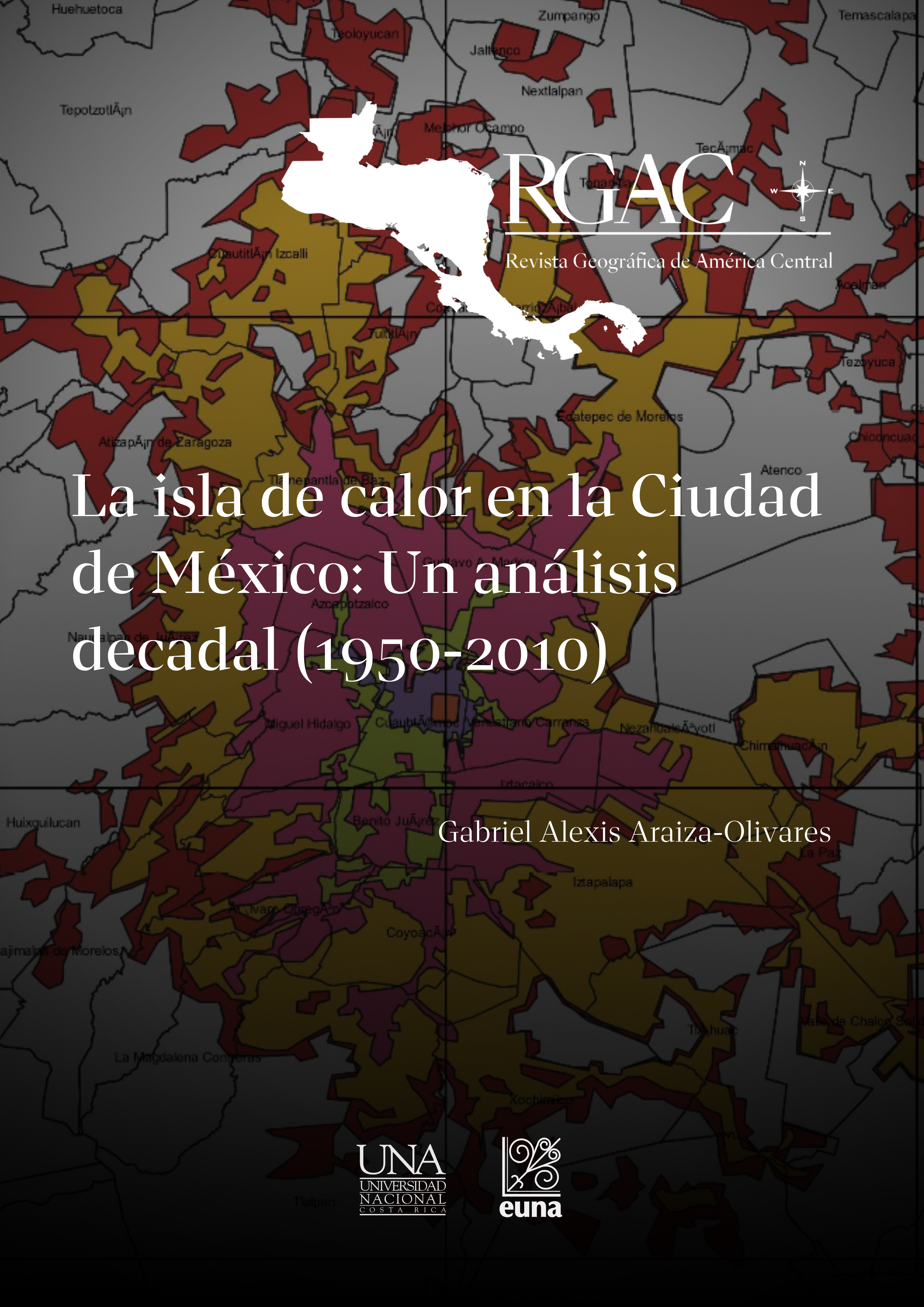The Heat Island in Mexico City: A Decadal Analysis (1950-2010)
DOI:
https://doi.org/10.15359/rgac.69-2.15Keywords:
Heat island, Urbanization, Urban sprawl, Population growthAbstract
This work analyzed the behavior shown by the heat island in Mexico City from 1950 to 2010. We worked with climatological data of average temperature per decade; the selection of the stations considered the period of operation and available data. The average temperature trend of three stations that met specific characteristics was studied. These characteristics were: being within the urban area from the start of the operation, having been absorbed by the urban area at some point in its period of operation, being in a rural area. The increase in temperature inside the urban area was verified over the period in contrast to the periurban area, which remained relatively stable; likewise, the isotherms showed a behavior of constant expansion as the urban area surface increased.
References
Akbari, H., Bell, R., Brazel, T., Cole, D., Estes, M., Heisler, G., Hitchcock, D., Johnson, B., Lewis, M., McPherson, G., Oke, T., Parker, D., Perrin, A., Ronsenthal, J., Sailor, D., Samenow, J., Taha, H., Voogt, J., Winner, D., Wolf, K. & Zalph, B. (2011). Reducing Urban Heat Islands: Compendium of Strategies Urban Heat Island Basics. Environmental Protection Agency.
Cao, W., Hu, J. X. & Yu, X. (2009). A study on temperature interpolation methods based on GIS. 2009 17th International Conference on Geoinformatics, Geoinformatics 2009, (4), 1-5. doi: http://dx.doi.org/10.1109/GEOINFORMATICS.2009.5293422
CICESE. (2021). Datos Climáticos del CLICOM del SMN. Recuperado de: http://clicom-mex.cicese.mx/
Chirinos, L. R. & Mallqui, C.G. (2016). Comparación entre interpoladores espaciales en el estudio de distribución de partículas sedimentables insolubles en la Cuenca Atmosférica de Lima y Callao. Información Tecnológica, 27(4), 111-120. doi: http://dx.doi.org/10.4067/S0718-07642016000400012
Climate Central. (2021). Hot Zones: Urban Heat Island.
Consejo Nacional de Población. (CONAPO, 2015). Delimitación de Zonas Metropolitanas 20015. México.
Consejo Nacional de Población. (CONAPO, 2018). Sistema Urbano Nacional 2018. México.
Córdova, K. (2011). Impactos de las islas térmicas o islas de calor urbano, en el ambiente y la salud humana. Análisis estacional comparativo: Caracas, octubre – 2009, marzo – 2010. Terra, 27(42), 95-122. Recuperado de: http://www.redalyc.org/articulo.oa?id=72121706005
Cruz, D., Reyes, M. & Bello, L. (2012). Control de calidad de datos. En L. Gómez & M. Medina (Comp.), Guía de Métodos Estadísticos en Climatología (20-24). México: Facultad de Filosofía y Letras, UNAM.
Fuentes, C. (2015). Climatología urbana por modificación antropogénica. Alteración del balance de energía natural. Contexto. Revista de la Facultad de Arquitectura de la Universidad Autónoma de Nuevo León, 9(11), 73-91. Recuperado de: https://www.redalyc.org/articulo.oa?id=353642518006
Giannaros, T. M., Melas, D., Daglis, I. A. & Keramitsoglou, I. (2014). Development of an operational modeling system for urban heat islands: An application to Athens, Greece. Natural Hazards and Earth System Sciences, 14(2), 347-358. doi: http://dx.doi.org/10.5194/nhess-14-347-2014
Gómez, N. & Velázquez, G. (2018) Asociación de los espacios verdes públicos y la calidad de vida en el municipio de Santa Fe, Argentina. Cuadernos de Geografía, 27(1), 164-179.
Gutiérrez, M. & González, J. (2010). Evolución del crecimiento espacial de la Ciudad de México en relación con las regiones geomorfológicas de la Cuenca de México. En R. Aguirre Gómez (Coord.), Geografía para el Siglo XXI (15-39). México, Instituto de Geografía, UNAM.
Gutiérrez, M., González. J. & Zamorano, J. (2005). La Cuenca de México y sus cambios demográficos-espaciales. Temas selectos de geografía de México. México: Instituto de Geografía, UNAM.
Jain, G. & Sarkar, S. (2017). Urban Heat Island: Causes, Effects & Mitigating Strategies. Imperial Journal of Interdisciplinary Research, 3(2), 67-73. doi: http://dx.doi.org/10.11648/j.ijema.20150302.15
Jáuregui-Ostos, E. (1975). Las zonas climáticas de la ciudad de México. Investigaciones Geográficas, 1(6), 47-58. http://dx.doi.org/10.14350/rig.58890
Martínez-Martínez, J. (2014). Estudio de la isla de calor de la ciudad de Alicante. Investigaciones Geográficas, (62), 88-99. doi: http://dx.doi.org/10.14198/INGEO2014.62.06
Mitáš, L. & Mitášová, H. (1988). General variational approach to the interpolation problem. Computers & Mathematics with Applications, 16(12), 983–992. doi: http://dx.doi.org/10.1016/0898-1221(88)90255-6
ONU-Habitat. (2018). Superficie de CDMX crece a ritmo tres veces superior al de su población. Recuperado de: https://onuhabitat.org.mx/index.php/superficie-de-cdmx-crece-a-ritmo-tres-veces-superior-al-de-su-poblacion
PAOT. (2018). Las Áreas Verdes en la Ciudad de México. Una visión integral. México: Autor.
SEDEMA. (2017). Inventario de Áreas Verdes. Recuperado de: https://sedema.cdmx.gob.mx/programas/programa/inventario-de-areas-verdes
Villanueva, J., Ranfla, A., Quintanilla, A. (2013). Isla de Calor Urbana: Modelación Dinámica y Evaluación de medidas de Mitigación en Ciudades de Clima árido Extremo. Información Tecnológica, 24(1), 15-24. doi: http://dx.doi.org/10.4067/S0718-07642013000100003

Published
How to Cite
Issue
Section
License
Proposed policy for journals offering Open Access
Authors publishing their works in the Journal acknowledge and agree to the following terms:
a) Authors retain the copyrights to their works and guarantee the Journal the right to be the first to publish their works, under the Creative Commons License Attribution-NonCommercial-ShareAlike 4.0 International, CC BY-NC-SA 4.0 International (https://creativecommons.org/licenses/by-nc-sa/4.0/deed.es), which allows others to share works upon complying with the acknowledgment of authorship and mention of the Journal as the original publisher of the work.
b) Authors are permitted to separately establish additional agreements for the non-exclusive distribution of the official edition of the work published in the Journal (for example, authors may desire to place the work in an institutional repository or incorporate it into a book that is to published elsewhere) so long they acknowledgment to recognize the Journal as the original publisher. The aforementioned additional agreements must respect the terms of the non-profit character and sharing philosophy of the original license (CC BY-NC-SA 4.0 International, https://creativecommons.org/licenses/by-nc-sa/4.0/deed.es).
c) Authors are encouraged to archive the post-print or editor/PDF version in Open Access repositories.





 REVGEO is licensed under https://creativecommons.org/licenses/by-nc-sa/4.0/deed.es
REVGEO is licensed under https://creativecommons.org/licenses/by-nc-sa/4.0/deed.es
.svg_4.png)

_(1).png)
_(1)_(1)_(1)_1.png)
(2)(1)(1)(1).png)
